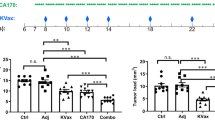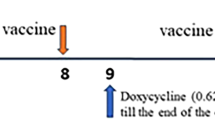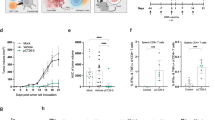Abstract
Mutant Kras (V-Ki-ras2 Kirsten rat sarcoma viral oncogene homolog) is observed in more than 20% of non-small-cell lung cancers; however, no effective Kras target therapy is available at present. The Kras DNA vaccine may represent as a novel immunotherapeutic agent in lung cancer. In this study, we investigated the antitumor efficacy of the Kras DNA vaccine in a genetically engineered inducible mouse lung tumor model driven by KrasG12D. Lung tumors were induced by doxycycline, and the therapeutic effects of Kras DNA vaccine were evaluated with delivery of KrasG12D plasmids. Mutant KrasG12D DNA vaccine significantly decreased the tumor nodules. A dominant-negative mutant KrasG12DN17, devoid of oncogenic activity, achieved similar therapeutic effects. The T-helper 1 immune response was enhanced in mice treated with Kras DNA vaccine. Splenocytes from mice receiving Kras DNA vaccine presented an antigen-specific response by treatment with peptides of Kras but not Hras or OVA. The number of tumor-infiltrating CD8+ T cells increased after Kras vaccination. In contrast, Kras DNA vaccine was not effective in the lung tumor in transgenic mice, which was induced by mutant L858R epidermal growth factor receptor. Overall, these results indicate that Kras DNA vaccine produces an effective antitumor response in transgenic mice, and may be useful in treating lung cancer-carrying Ras mutation.
This is a preview of subscription content, access via your institution
Access options
Subscribe to this journal
Receive 12 print issues and online access
$259.00 per year
only $21.58 per issue
Buy this article
- Purchase on Springer Link
- Instant access to full article PDF
Prices may be subject to local taxes which are calculated during checkout





Similar content being viewed by others
References
Siegel R, Naishadham D, Jemal A . Cancer statistics, 2012. CA Cancer J Clin 2012; 62: 10–29.
Putila J, Remick SC, Guo NL . Combining clinical, pathological, and demographic factors refines prognosis of lung cancer: a population-based study. PLoS One 2011; 6: e17493.
Herbst RS, Heymach JV, Lippman SM . Lung cancer. N Engl J Med 2008; 359: 1367–1380.
Sunaga N, Shames DS, Girard L, Peyton M, Larsen JE, Imai H et al. Knockdown of oncogenic KRAS in non-small cell lung cancers suppresses tumor growth and sensitizes tumor cells to targeted therapy. Mol Cancer Ther 2011; 10: 336–346.
Riely GJ, Marks J, Pao W . KRAS mutations in non-small cell lung cancer. Proc Am Thorac Soc 2009; 6: 201–205.
Roberts PJ, Stinchcombe TE . KRAS mutation: should we test for it, and does it matter? J Clin Oncol 2013; 31: 1112–1121.
Kranenburg O . The KRAS oncogene: past, present, and future. Biochim Biophys Acta 2005; 1756: 81–82.
Hirsch FR, Varella-Garcia M, Bunn PA Jr, Di Maria MV, Veve R, Bremmes RM et al. Epidermal growth factor receptor in non-small-cell lung carcinomas: correlation between gene copy number and protein expression and impact on prognosis. J Clin Oncol 2003; 21: 3798–3807.
Davies BR, Logie A, McKay JS, Martin P, Steele S, Jenkins R et al. AZD6244 (ARRY-142886), a potent inhibitor of mitogen-activated protein kinase/extracellular signal-regulated kinase kinase 1/2 kinases: mechanism of action in vivo, pharmacokinetic/pharmacodynamic relationship, and potential for combination in preclinical models. Mol Cancer Ther 2007; 6: 2209–2219.
Gilmartin AG, Bleam MR, Groy A, Moss KG, Minthorn EA, Kulkarni SG et al. GSK1120212 (JTP-74057) is an inhibitor of MEK activity and activation with favorable pharmacokinetic properties for sustained in vivo pathway inhibition. Clin Cancer Res 2011; 17: 989–1000.
Sebti SM, Hamilton AD . Farnesyltransferase and geranylgeranyltransferase I inhibitors and cancer therapy: lessons from mechanism and bench-to-bedside translational studies. Oncogene 2000; 19: 6584–6593.
Cox AD, Der CJ . Farnesyltransferase inhibitors: promises and realities. Curr Opin Pharmacol 2002; 2: 388–393.
Downward J . Targeting RAS signalling pathways in cancer therapy. Nat rev Cancer 2003; 3: 11–22.
Califano R, Landi L, Cappuzzo F . Prognostic and predictive value of K-RAS mutations in non-small cell lung cancer. Drugs 2012; 72 (Suppl 1) 28–36.
Gjertsen MK, Bjorheim J, Saeterdal I, Myklebust J, Gaudernack G . Cytotoxic CD4+ and CD8+ T lymphocytes, generated by mutant p21-ras (12Val) peptide vaccination of a patient, recognize 12Val-dependent nested epitopes present within the vaccine peptide and kill autologous tumour cells carrying this mutation. Int J Cancer 1997; 72: 784–790.
Tan G, Wang Z, Zhang X, Cai Z, Zhang J . Induction of CTLs by DCs pulsed with K-ras mutant peptide on the surface of nanoparticles in the treatment of pancreatic cancer. Oncol Rep 2011; 26: 215–221.
Gjertsen MK, Saeterdal I, Saeboe-Larssen S, Gaudernack G . HLA-A3 restricted mutant ras specific cytotoxic T-lymphocytes induced by vaccination with T-helper epitopes. J Mol Med (Berl) 2003; 81: 43–50.
Abou-Alfa GK, Chapman PB, Feilchenfeldt J, Brennan MF, Capanu M, Gansukh B et al. Targeting mutated K-ras in pancreatic adenocarcinoma using an adjuvant vaccine. Am J Clin Oncol 2011; 34: 321–325.
Rice J, Ottensmeier CH, Stevenson FK . DNA vaccines: precision tools for activating effective immunity against cancer. Nat rev Cancer 2008; 8: 108–120.
Alarcon JB, Waine GW, McManus DP . DNA vaccines: technology and application as anti-parasite and anti-microbial agents. Adv Parasitol 1999; 42: 343–410.
Gurunathan S, Wu CY, Freidag BL, Seder RA . DNA vaccines: a key for inducing long-term cellular immunity. Curr Opin Immunol 2000; 12: 442–447.
Lin CC, Yen MC, Lin CM, Huang SS, Yang HJ, Chow NH et al. Delivery of noncarrier naked DNA vaccine into the skin by supersonic flow induces a polarized T helper type 1 immune response to cancer. J Gene Med 2008; 10: 679–689.
Trimble C, Lin CT, Hung CF, Pai S, Juang J, He L et al. Comparison of the CD8+ T cell responses and antitumor effects generated by DNA vaccine administered through gene gun, biojector, and syringe. Vaccine 2003; 21: 4036–4042.
Garg S, Oran A, Wajchman J, Sasaki S, Maris CH, Kapp JA et al. Genetic tagging shows increased frequency and longevity of antigen-presenting, skin-derived dendritic cells in vivo. Nat Immunol 2003; 4: 907–912.
Kim TW, Hung CF, Ling M, Juang J, He L, Hardwick JM et al. Enhancing DNA vaccine potency by coadministration of DNA encoding antiapoptotic proteins. J Clin Invest 2003; 112: 109–117.
Lai MD, Yen MC, Lin CM, Tu CF, Wang CC, Lin PS et al. The effects of DNA formulation and administration route on cancer therapeutic efficacy with xenogenic EGFR DNA vaccine in a lung cancer animal model. Genet Vaccines Ther 2009; 7: 2.
Lin CC, Chou CW, Shiau AL, Tu CF, Ko TM, Chen YL et al. Therapeutic HER2/Neu DNA vaccine inhibits mouse tumor naturally overexpressing endogenous neu. Mol Ther 2004; 10: 290–301.
Lum DH, Matsen C, Welm AL, Welm BE . Overview of human primary tumorgraft models: comparisons with traditional oncology preclinical models and the clinical relevance and utility of primary tumorgrafts in basic and translational oncology research. Curr Protoc Pharmacol 2012; 59: 14.22.1–14.22.9.
Egeblad M, Nakasone ES, Werb Z . Tumors as organs: complex tissues that interface with the entire organism. Dev Cell 2010; 18: 884–901.
Lin EY, Jones JG, Li P, Zhu L, Whitney KD, Muller WJ et al. Progression to malignancy in the polyoma middle T oncoprotein mouse breast cancer model provides a reliable model for human diseases. Am J Pathol 2003; 163: 2113–2126.
Whiteford CC, Bilke S, Greer BT, Chen Q, Braunschweig TA, Cenacchi N et al. Credentialing preclinical pediatric xenograft models using gene expression and tissue microarray analysis. Cancer Res 2007; 67: 32–40.
Ito K, Shinohara N, Kato S . DNA immunization via intramuscular and intradermal routes using a gene gun provides different magnitudes and durations on immune response. Mol immunol 2003; 39: 847–854.
Wang S, Zhang C, Zhang L, Li J, Huang Z, Lu S . The relative immunogenicity of DNA vaccines delivered by the intramuscular needle injection, electroporation and gene gun methods. Vaccine 2008; 26: 2100–2110.
Stewart S, Guan KL . The dominant negative Ras mutant, N17Ras, can inhibit signaling independently of blocking Ras activation. J Biol Chem 2000; 275: 8854–8862.
Politi K, Zakowski MF, Fan PD, Schonfeld EA, Pao W, Varmus HE . Lung adenocarcinomas induced in mice by mutant EGF receptors found in human lung cancers respond to a tyrosine kinase inhibitor or to down-regulation of the receptors. Genes Dev 2006; 20: 1496–1510.
Schoenborn JR, Wilson CB . Regulation of interferon-gamma during innate and adaptive immune responses. Adv Immunol 2007; 96: 41–101.
Aviel-Ronen S, Blackhall FH, Shepherd FA, Tsao MS . K-ras mutations in non-small-cell lung carcinoma: a review. Clin Lung Cancer 2006; 8: 30–38.
Graziano SL, Gamble GP, Newman NB, Abbott LZ, Rooney M, Mookherjee S et al. Prognostic significance of K-ras codon 12 mutations in patients with resected stage I and II non-small-cell lung cancer. J Clin Oncol 1999; 17: 668–675.
van Zandwijk N, Mooi WJ, Rodenhuis S . Prognostic factors in NSCLC. Recent experiences. Lung Cancer 1995; 12 (Suppl 1) S27–S33.
Massarelli E, Varella-Garcia M, Tang X, Xavier AC, Ozburn NC, Liu DD et al. KRAS mutation is an important predictor of resistance to therapy with epidermal growth factor receptor tyrosine kinase inhibitors in non-small-cell lung cancer. Clin Cancer Res 2007; 13: 2890–2896.
Eberhard DA, Johnson BE, Amler LC, Goddard AD, Heldens SL, Herbst RS et al. Mutations in the epidermal growth factor receptor and in KRAS are predictive and prognostic indicators in patients with non-small-cell lung cancer treated with chemotherapy alone and in combination with erlotinib. J Clin Oncol 2005; 23: 5900–5909.
Pao W, Miller V, Zakowski M, Doherty J, Politi K, Sarkaria I et al. EGF receptor gene mutations are common in lung cancers from ‘never smokers’ and are associated with sensitivity of tumors to gefitinib and erlotinib. Proc Natl Acad Sci USA 2004; 101: 13306–13311.
Cho HC, Lai CY, Shao LE, Yu J . Identification of tumorigenic cells in Kras(G12D)-induced lung adenocarcinoma. Cancer Res 2011; 71: 7250–7258.
Garassino MC, Marabese M, Rusconi P, Rulli E, Martelli O, Farina G et al. Different types of K-Ras mutations could affect drug sensitivity and tumour behaviour in non-small-cell lung cancer. Ann Oncol 2011; 22: 235–237.
Bray F, Ren JS, Masuyer E, Ferlay J . Global estimates of cancer prevalence for 27 sites in the adult population in 2008. Int J Cancer 2013; 132: 1133–1145.
Soda M, Choi YL, Enomoto M, Takada S, Yamashita Y, Ishikawa S et al. Identification of the transforming EML4-ALK fusion gene in non-small-cell lung cancer. Nature 2007; 448: 561–566.
Carbone DP, Ciernik IF, Kelley MJ, Smith MC, Nadaf S, Kavanaugh D et al. Immunization with mutant p53- and K-ras-derived peptides in cancer patients: immune response and clinical outcome. J Clin Oncol 2005; 23: 5099–5107.
Blanchard P, Quero L, Pacault V, Schlageter MH, Baruch-Hennequin V, Hennequin C . Prognostic significance of anti-p53 and anti-KRas circulating antibodies in esophageal cancer patients treated with chemoradiotherapy. BMC cancer 2012; 12: 119.
Takahashi M, Chen W, Byrd DR, Disis ML, Huseby ES, Qin H et al. Antibody to ras proteins in patients with colon cancer. Clin Cancer Res 1995; 1: 1071–1077.
Toubaji A, Achtar M, Provenzano M, Herrin VE, Behrens R, Hamilton M et al. Pilot study of mutant ras peptide-based vaccine as an adjuvant treatment in pancreatic and colorectal cancers. Cancer Immunol Immunother 2008; 57: 1413–1420.
He XP, Song FJ, Liu XY, Wang Z, Li XX, Liu FY et al. The relationship between KRAS gene mutations and HLA class I antigen downregulation in the metastasis of non-small cell lung cancer. J Int Med Res 2013; 41: 1473–1483.
Feltquate DM, Heaney S, Webster RG, Robinson HL . Different T helper cell types and antibody isotypes generated by saline and gene gun DNA immunization. J Immunol 1997; 158: 2278–2284.
Yoshida A, Koide Y, Uchijima M, Yoshida TO . IFN-gamma induces IL-12 mRNA expression by a murine macrophage cell line, J774. Biochem Biophys Res Commun 1994; 198: 857–861.
Hayes MP, Murphy FJ, Burd PR . Interferon-gamma-dependent inducible expression of the human interleukin-12 p35 gene in monocytes initiates from a TATA-containing promoter distinct from the CpG-rich promoter active in Epstein–Barr virus-transformed lymphoblastoid cells. Blood 1998; 91: 4645–4651.
Song JM, Kim YC, Compans OE, Prausnitz RW, Kang MR, DNA SM . vaccination in the skin using microneedles improves protection against influenza. Mol Ther 2012; 20: 1472–1480.
Hemmerle T, Neri D . The antibody-based targeted delivery of interleukin-4 and 12 to the tumor neovasculature eradicates tumors in three mouse models of cancer. Int J Cancer 2014; 134: 467–477.
Cavallo F, Offringa R, van der Burg SH, Forni G, Melief CJ . Vaccination for treatment and prevention of cancer in animal models. Adv Immunol 2006; 90: 175–213.
Le Borgne M, Etchart N, Goubier A, Lira SA, Sirard JC, van Rooijen N et al. Dendritic cells rapidly recruited into epithelial tissues via CCR6/CCL20 are responsible for CD8+ T cell crosspriming in vivo. Immunity 2006; 24: 191–201.
Cheng WF, Hung CF, Lin KY, Ling M, Juang J, He L et al. CD8+ T cells, NK cells and IFN-gamma are important for control of tumor with downregulated MHC class I expression by DNA vaccination. Gene Therapy 2003; 10: 1311–1320.
Huang TT, Yen MC, Lin CC, Weng TY, Chen YL, Lin CM et al. Skin delivery of short hairpin RNA of indoleamine 2,3 dioxygenase induces antitumor immunity against orthotopic and metastatic liver cancer. Cancer sci 2011; 102: 2214–2220.
Mincheff M, Tchakarov S, Zoubak S, Loukinov D, Botev C, Altankova I et al. Naked DNA and adenoviral immunizations for immunotherapy of prostate cancer: a phase I/II clinical trial. Eur urol 2000; 38: 208–217.
Tacket CO, Roy MJ, Widera G, Swain WF, Broome S, Edelman R . Phase 1 safety and immune response studies of a DNA vaccine encoding hepatitis B surface antigen delivered by a gene delivery device. Vaccine 1999; 17: 2826–2829.
Tu CF, Lin CC, Chen MC, Ko TM, Lin CM, Wang YC et al. Autologous neu DNA vaccine can be as effective as xenogenic neu DNA vaccine by altering administration route. Vaccine 2007; 25: 719–728.
Soong RS, Trieu J, Lee SY, He L, Tsai YC, Wu TC et al. Xenogeneic human p53 DNA vaccination by electroporation breaks immune tolerance to control murine tumors expressing mouse p53. PLoS One 2013; 8: e56912.
Soong RS, Song L, Trieu J, Lee SY, He L, Tsai YC et al. Direct T cell activation via CD40 ligand generates high avidity CD8+ T cells capable of breaking immunological tolerance for the control of tumors. PLoS One 2014; 9: e93162.
Occhipinti S, Sponton L, Rolla S, Caorsi C, Novarino A, Donadio M et al. Chimeric Rat/human HER2 efficiently circumvents HER2 tolerance in cancer patients. Clin Cancer Res 2014.
Hsu TI, Wang MC, Chen SY, Yeh YM, Su WC, Chang WC et al. Sp1 expression regulates lung tumor progression. Oncogene 2012; 31: 3973–3988.
Acknowledgements
This study is supported by the Grants NSC-102-2325-B-006-007 (from National Science Council, Taiwan) and NHRI-EX100-9927B1 (from National Health Research Institute, Taiwan) to MDL. To establish Centers of Excellence for Cancer Research in Taiwan, funding was provided by the Grant DOH101-TD-C-111-003 (Department of Health, Executive Yuan, Taiwan).
Author information
Authors and Affiliations
Corresponding author
Ethics declarations
Competing interests
The authors declare no conflict of interest.
Additional information
Supplementary Information accompanies this paper on Gene Therapy website
Supplementary information
Rights and permissions
About this article
Cite this article
Weng, TY., Yen, MC., Huang, CT. et al. DNA vaccine elicits an efficient antitumor response by targeting the mutant Kras in a transgenic mouse lung cancer model. Gene Ther 21, 888–896 (2014). https://doi.org/10.1038/gt.2014.67
Received:
Revised:
Accepted:
Published:
Issue Date:
DOI: https://doi.org/10.1038/gt.2014.67
This article is cited by
-
A novel intranasal peptide vaccine inhibits non-small cell lung cancer with KRAS mutation
Cancer Gene Therapy (2024)
-
Homoharringtonine induced immune alteration for an Efficient Anti-tumor Response in Mouse Models of Non-small Cell Lung Adenocarcinoma Expressing Kras Mutation
Scientific Reports (2018)



